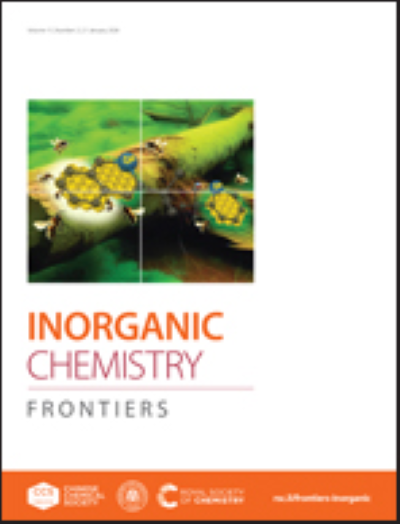具有以卤素为中心的二级建筑单元的深紫外氨基甲酸盐卤化物,用于增强光学各向异性
IF 6.1
1区 化学
Q1 CHEMISTRY, INORGANIC & NUCLEAR
引用次数: 0
摘要
非π共轭光学材料的双折射率不足是其应用于深紫外(DUV)的一个重大挑战。在本研究中,四种DUV磺胺盐卤化物共晶,AX(NH3SO3) (A = Rb, Cs;X = Cl, Br),通过功能发色团工程成功合成。这四种化合物都表现出很好的DUV透明窗口,其中RbCl(NH3SO3)和CsCl(NH3SO3)在185 nm以下表现出较短的DUV截止边。值得注意的是,在所有四种晶体中都观察到双折射的显著改善,范围从0.069到0.075。这些值代表了非π共轭DUV光学材料观察到的最高双折射,并表现出与含有π共轭基团的DUV材料相当的光学各向异性。采用实空间原子切割方法的理论分析表明,[XAm] (X = Cl, Br;A = Rb, Cs)次级建筑单元(SBUs)对双折射有重要贡献。卤素中心发色团的加入为设计具有增强双折射和相位匹配能力的非π共轭DUV材料提供了一种新的策略。本文章由计算机程序翻译,如有差异,请以英文原文为准。
Deep-ultraviolet sulfamate halides with halogen-centered secondary building units for enhanced optical anisotropy
The insufficient birefringence of non-π-conjugated optical materials presents a significant challenge for their deep-ultraviolet (DUV) applications. In this work, four DUV sulfamate halide co-crystals, AX(NH3SO3) (A = Rb, Cs; X = Cl, Br), were successfully synthesized through functional chromophore engineering. All four compounds exhibit promising DUV transparent windows, with RbCl(NH3SO3) and CsCl(NH3SO3) demonstrating short DUV cut-off edges below 185 nm. Remarkably, a significant improvement in birefringence, ranging from 0.069 to 0.075, was observed in all four crystals. These values represent the highest birefringence observed for non-π-conjugated DUV optical materials and exhibit optical anisotropy comparable to that of DUV materials containing π-conjugated groups. Theoretical analysis using the real-space atom-cutting method reveals that the [XAm] (X = Cl, Br; A = Rb, Cs) secondary building units (SBUs) contribute significantly to the birefringence. The incorporation of halogen-centered chromophores provides a novel strategy for designing non-π-conjugated DUV materials with enhanced birefringence and phase-matching capabilities.
求助全文
通过发布文献求助,成功后即可免费获取论文全文。
去求助
来源期刊

Inorganic Chemistry Frontiers
CHEMISTRY, INORGANIC & NUCLEAR-
CiteScore
10.40
自引率
7.10%
发文量
587
审稿时长
1.2 months
期刊介绍:
The international, high quality journal for interdisciplinary research between inorganic chemistry and related subjects
 求助内容:
求助内容: 应助结果提醒方式:
应助结果提醒方式:


